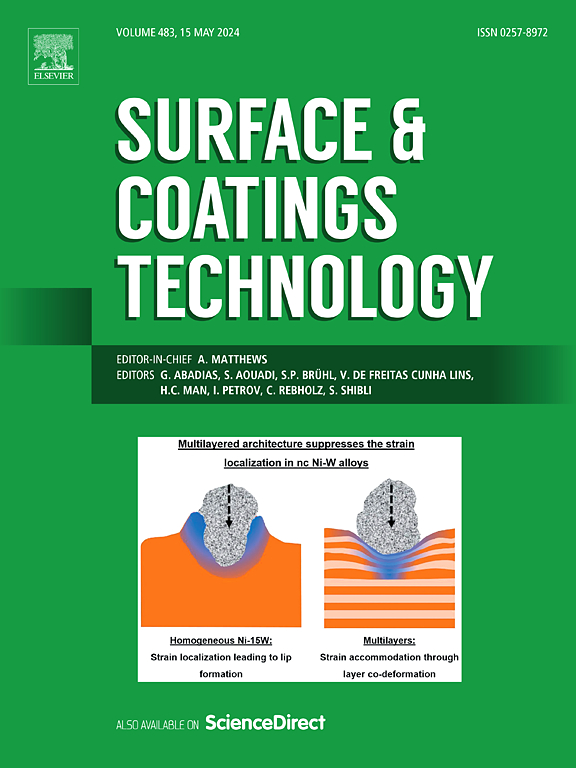Effect of interface roughness on the CMAS + molten salt (Na2SO4 + NaCl + NaVO3) corrosion resistance of EB-PVD thermal barrier coatings
IF 6.1
2区 材料科学
Q1 MATERIALS SCIENCE, COATINGS & FILMS
引用次数: 0
Abstract
The service life of thermal barrier coatings (TBCs) in calcium magnesium aluminosilicate (CMAS) and molten salt environments has become a key factor in determining engine reliability and safety. The effect of interface roughness (bond coating surface roughness) on the CM (CMAS + molten salt (Na2SO4 + NaCl + NaVO3)) corrosion resistance of electron beam physical vapor deposition (EB-PVD) TBCs is investigated. The addition of molten salts lowers the melting point of CM, leading to more severe destructive effects compared to single CMAS corrosion. Moreover, the 1200# specimen (Ra = 2.0 μm) exhibits the best resistance to CM corrosion. The adjustment of interface roughness significantly alters the microstructure of the top-ceramic coating and induces changes in crack patterns after CM corrosion. Therefore, appropriately reducing interface roughness is key to improving the isothermal CM corrosion resistance and high-temperature CM corrosion-induced thermal shock performance of TBCs.
界面粗糙度对EB-PVD热障涂层CMAS +熔盐(Na2SO4 + NaCl + NaVO3)耐蚀性能的影响
热障涂层在钙镁铝硅酸盐(CMAS)和熔盐环境中的使用寿命已成为决定发动机可靠性和安全性的关键因素。研究了界面粗糙度(键合涂层表面粗糙度)对电子束物理气相沉积(EB-PVD) TBCs (CMAS +熔盐(Na2SO4 + NaCl + NaVO3))耐蚀性能的影响。熔盐的加入降低了CM的熔点,导致比单一CMAS腐蚀更严重的破坏性影响。其中,1200#试样(Ra = 2.0 μm)的抗CM腐蚀性能最好。界面粗糙度的调整显著改变了顶部陶瓷涂层的微观组织,并引起CM腐蚀后裂纹模式的变化。因此,适当降低界面粗糙度是提高tbc耐等温CM腐蚀和高温CM腐蚀热冲击性能的关键。
本文章由计算机程序翻译,如有差异,请以英文原文为准。
求助全文
约1分钟内获得全文
求助全文
来源期刊

Surface & Coatings Technology
工程技术-材料科学:膜
CiteScore
10.00
自引率
11.10%
发文量
921
审稿时长
19 days
期刊介绍:
Surface and Coatings Technology is an international archival journal publishing scientific papers on significant developments in surface and interface engineering to modify and improve the surface properties of materials for protection in demanding contact conditions or aggressive environments, or for enhanced functional performance. Contributions range from original scientific articles concerned with fundamental and applied aspects of research or direct applications of metallic, inorganic, organic and composite coatings, to invited reviews of current technology in specific areas. Papers submitted to this journal are expected to be in line with the following aspects in processes, and properties/performance:
A. Processes: Physical and chemical vapour deposition techniques, thermal and plasma spraying, surface modification by directed energy techniques such as ion, electron and laser beams, thermo-chemical treatment, wet chemical and electrochemical processes such as plating, sol-gel coating, anodization, plasma electrolytic oxidation, etc., but excluding painting.
B. Properties/performance: friction performance, wear resistance (e.g., abrasion, erosion, fretting, etc), corrosion and oxidation resistance, thermal protection, diffusion resistance, hydrophilicity/hydrophobicity, and properties relevant to smart materials behaviour and enhanced multifunctional performance for environmental, energy and medical applications, but excluding device aspects.
 求助内容:
求助内容: 应助结果提醒方式:
应助结果提醒方式:


